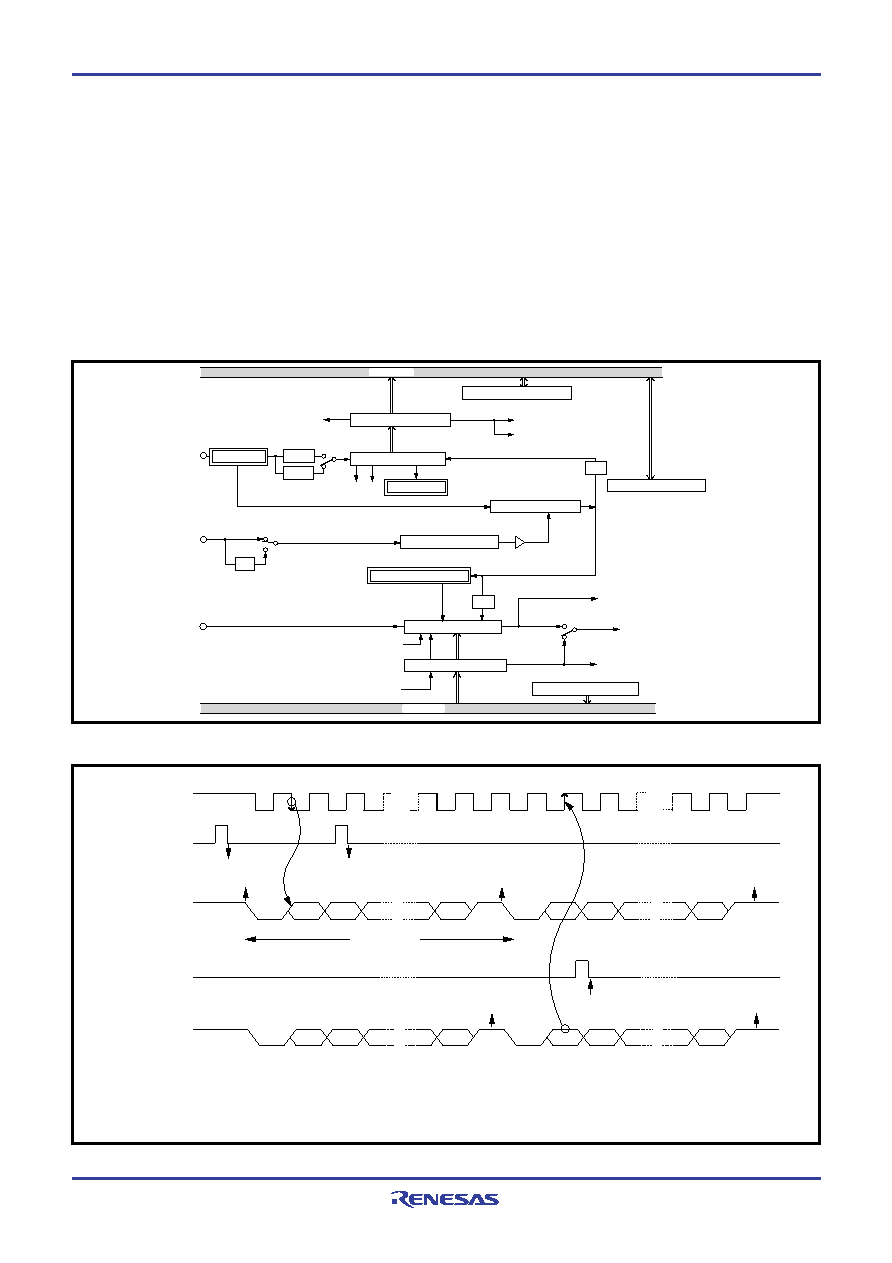- 您現(xiàn)在的位置:買賣IC網(wǎng) > PDF目錄98006 > M37534M4-XXXGP 8-BIT, MROM, 6 MHz, MICROCONTROLLER, PQFP32 PDF資料下載
參數(shù)資料
| 型號: | M37534M4-XXXGP |
| 元件分類: | 微控制器/微處理器 |
| 英文描述: | 8-BIT, MROM, 6 MHz, MICROCONTROLLER, PQFP32 |
| 封裝: | 7 X 7 MM, 0.80 MM PITCH, PLASTIC, LQFP-32 |
| 文件頁數(shù): | 16/58頁 |
| 文件大小: | 753K |
| 代理商: | M37534M4-XXXGP |
第1頁第2頁第3頁第4頁第5頁第6頁第7頁第8頁第9頁第10頁第11頁第12頁第13頁第14頁第15頁當(dāng)前第16頁第17頁第18頁第19頁第20頁第21頁第22頁第23頁第24頁第25頁第26頁第27頁第28頁第29頁第30頁第31頁第32頁第33頁第34頁第35頁第36頁第37頁第38頁第39頁第40頁第41頁第42頁第43頁第44頁第45頁第46頁第47頁第48頁第49頁第50頁第51頁第52頁第53頁第54頁第55頁第56頁第57頁第58頁

7534 Group
Rev.3.00
Oct 23, 2006
page 21 of 53
REJ03B0099-0300
Fig. 22 Block diagram of UART serial I/O
Fig. 23 Operation of UART serial I/O function
Serial Interface
qSerial I/O1
Asynchronous serial I/O (UART) mode
Serial I/O1 can be used as an asynchronous (UART) serial I/O. A
dedicated timer (baud rate generator) is also provided for baud rate
generation when serial I/O1 is in operation.
Eight serial data transfer formats can be selected, and the transfer
formats to be used by a transmitter and a receiver must be identi-
cal.
Each of the transmit and receive shift registers has a buffer register
(the same address on memory). Since the shift register cannot be
written to or read from directly, transmit data is written to the trans-
mit buffer, and receive data is read from the respective buffer regis-
ters. These buffer registers can also hold the next data to be trans-
mitted and receive 2-byte receive data in succession.
By selecting “1” for continuous transmit valid bit (bit 2 of SIO1CON),
continuous transmission of the same data is made possible.
This can be used as a simplified PWM.
OE
PE FE
1/16
XIN
1/4
1/16
Data bus
Receive Buffer Register
Address
(001816)
Receive Shift Register
Receive buffer full flag (RBF)
Receive interrupt request (RI)
ST Detector
SP Detector
UART Control Register
Address (001A16)
Character length selection bit
7-bit
8-bit
Address (001B16)
Clock Control Circuit
Baud Rate Generator
Division ratio 1/(n+1)
Address (001C16)
BRG count source selection bit
Transmit Buffer Register
Data bus
Transmit Shift Register
Address
(001816)
Transmit shift register shift
completion flag (TSC)
Transmit buffer empty flag (TBE)
Transmit interrupt request (TI)
Address (001916)
Character length selection bit
Transmit interrupt source selection bit
Continuous transmit valid bit
Serial I/O1 control register
P10/RXD
P11/TXD
Serial I/O1 status register
ST/SP/PA Generator
TSC=0
TBE=1
RBF=0
TBE=0
RBF=1
ST
D0
D1
SP
D0
D1
ST
SP
TBE=1
TSC=1*
ST
D0
D1
SP
D0
D1
ST
SP
1 : Error flag detection occurs at the same time that the RBF flag becomes “1” (at 1st stop bit, during reception).
2 : The transmit interrupt (TI) can be selected to occur when either the TBE or TSC flag becomes “1”, depending on the setting of the transmit
interrupt source selection bit (TIC) of the serial I/O1 control register.
3 : The receive interrupt (RI) is set when the RBF flag becomes “1”.
4 : After data is written to the transmit buffer when TSC = 1, 0.5 to 1.5 cycles of the data shift cycle is necessary until changing to TSC = 0.
Notes
Transmit/Receive Clock
Transmit Buffer Register
Write Signal
Serial Output TXD
Receive Buffer Register
Read Signal
Serial Input RXD
* Generated at second bit in 2-stop -bit
mode
1 Start Bit
7 or 8 Data Bit
1 or 0 Parity Bit
1 or 2 Stop Bit
相關(guān)PDF資料 |
PDF描述 |
|---|---|
| M37534M4-XXXGP | 8-BIT, MROM, 6 MHz, MICROCONTROLLER, PQFP32 |
| M37534E4GP | 8-BIT, OTPROM, 6 MHz, MICROCONTROLLER, PQFP32 |
| M37548G3FP | 8-BIT, MROM, 8 MHz, MICROCONTROLLER, PDSO20 |
| M37548G1FP | 8-BIT, MROM, 8 MHz, MICROCONTROLLER, PDSO20 |
| M37548G2-XXXFP | 8-BIT, MROM, 8 MHz, MICROCONTROLLER, PDSO20 |
相關(guān)代理商/技術(shù)參數(shù) |
參數(shù)描述 |
|---|---|
| M37534M4-XXXSP | 制造商:RENESAS 制造商全稱:Renesas Technology Corp 功能描述:SINGLE-CHIP 8-BIT CMOS MICROCOMPUTER |
| M37534RSS | 制造商:RENESAS 制造商全稱:Renesas Technology Corp 功能描述:SINGLE-CHIP 8-BIT CMOS MICROCOMPUTER |
| M37536E8SP | 制造商:MITSUBISHI 制造商全稱:Mitsubishi Electric Semiconductor 功能描述:SINGLE-CHIP 8-BIT CMOS MICROCOMPUTER |
| M37536M4 | 制造商:MITSUBISHI 制造商全稱:Mitsubishi Electric Semiconductor 功能描述:SINGLE-CHIP 8-BIT CMOS MICROCOMPUTER |
| M37536M4-XXXSP | 制造商:MITSUBISHI 制造商全稱:Mitsubishi Electric Semiconductor 功能描述:SINGLE-CHIP 8-BIT CMOS MICROCOMPUTER |
發(fā)布緊急采購,3分鐘左右您將得到回復(fù)。